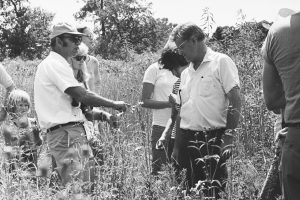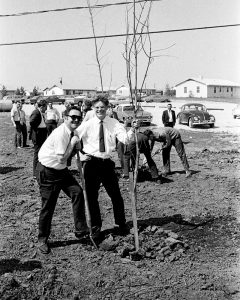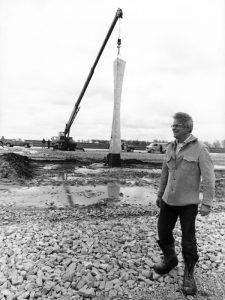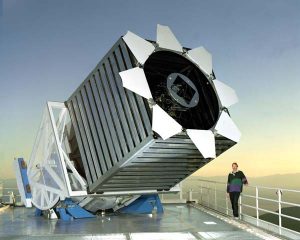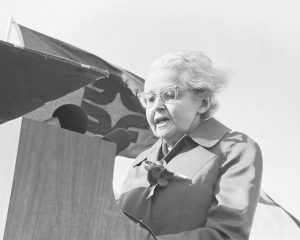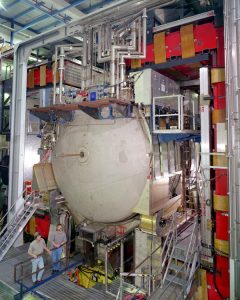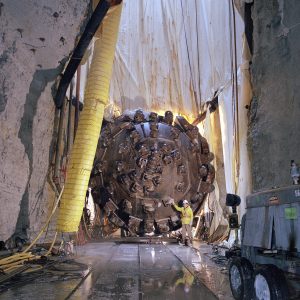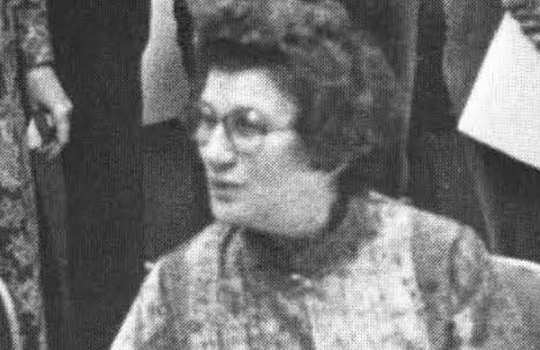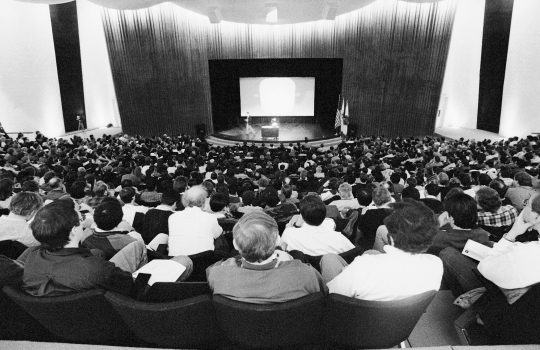It was during the springtime month of May that Fermilab celebrated its first Arbor Day. It also received the name Fermi National Accelerator Laboratory in May, during a dedication attended by Laura Fermi. DZero observed its first collisions in May. Read on for more May milestones.
May 1974: Prairie restoration begins
In May 1974, the lab began its efforts to restore the prairie that once occupied the site by planting several small plots of native plants. The project was directed by an Advisory Committee led by Robert Betz of Northeastern Illinois University, along with people from the Morton Arboretum, the Illinois Chapter of The Nature Conservancy and the Cook County Forest Preserves. They were assisted by the lab Prairie Committee, which was composed of interested lab employees. In June 1975, the lab planted the first 13 acres of native prairie on the land encircled by the Main Ring using seeds from the first lab plots, Morton Arboretum and the prairie remnant at Markham, Illinois.
May 1, 2009: NOvA detector building groundbreaking
NOvA (NuMI Off-Axis Electron Neutrino Appearance) was the successor to MINOS. NOνA scientists use a 300-ton particle detector at Fermilab (the near detector) and a 14,000-ton detector in northern Minnesota (the far detector) to study neutrino oscillations. NOvA began construction of the far detector building in Ash River, Minnesota on May 1, 2009.
May 2, 1969: First Arbor Day
Lab director Robert R. Wilson sought to preserve and enhance the natural beauty of the lab site, which he accomplished in part by rerouting certain roads on site to preserve some of the largest trees and working with lab staff to plant trees at the lab’s first annual Arbor Day celebration, held just six months after the NAL staff finished moving to the site.
May 9, 1978: Acqua Alle Funi sculpture erected
Lab director Robert R. Wilson designed the hyperbolic obelisk sculpture that stands in the reflection pond in front of Wilson Hall. Wilson, with assistance from lab staff, had worked on the sculpture since January.
May 9, 1998: Sloan Digital Sky Survey receives first light
Fermilab has played a key role in the Sloan Digital Sky Survey, an international effort that uses a telescope based in New Mexico to create detailed maps of the universe. The telescope began its observations on May 9, 1998, and Fermilab director John Peoples served as its director from 1998 to 2003.
May 11, 1974: Dedication of the lab
On a windy day in May 1974, Atomic Energy Commission (AEC) Chair Dixy Lee Ray dedicated the National Accelerator Laboratory as the Fermi National Accelerator Laboratory. In 1969, the AEC had announced its decision to name the lab in honor of Nobel Prize-winning Italian physicist Enrico Fermi, famous for producing the world’s first controlled, self-sustaining nuclear chain reaction at the University of Chicago in 1942 and for naming the neutrino. The wartime work of Fermi and other physicists had led to the creation of the AEC and the national laboratory system. Enrico Fermi’s widow, Laura Fermi, spoke at the event.
May 12, 1992: DZero observes first collisions
When planning for DZero began in 1983, it was envisioned as an experiment that would complement CDF by observing and analyzing proton-antiproton collisions using different techniques. DZero received formal funding approval in early 1985, construction began in July 1985, and the experiment began detecting proton-antiproton collisions on May 12, 1992. DZero, an international collaboration of, at its peak, more than 600 physicists from 18 countries, would become one of Fermilab’s flagship experiments.
May 31, 2000: NuMI groundbreaking ceremony
On a stormy day in May, Fermilab held the groundbreaking ceremony for the NuMI (Neutrinos at the Main Injector) beam. The NuMI beam used the Main Injector proton beam to strike a carbon target and generate the world’s most intense beam of neutrinos, a key part of Fermilab’s move towards focusing on neutrino physics. The beam was completed in 2005.

